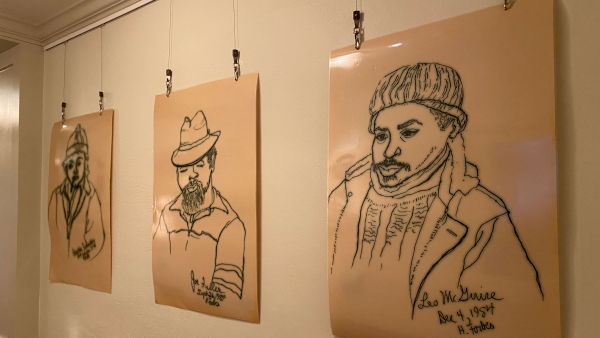Harriette Forbes-Olivier's "To See and Be Seen" in the Glenn Gallery

From 1980 to 1991, Harriette Forbes-Olivier, an Atlanta artist, drew more than 200 portraits of the guests of Crossroads Community Ministries. These portraits were made with a black marker on a large piece of sketching paper.
The life-size portraits were executed on 30” x 40” drawing paper. The medium is a black felt tip pen or perhaps a Magic Marker. The individuals in the portraits appear comfortable and calm, almost always looking into the eyes of the observer. Each portrait includes the name of the person whose portrait has been drawn, along with date and the artist’s signature.
These portraits were exhibited in New York at St. Bartholomew’s on Park Avenue, in Atlanta at St. Luke’s and other locations.
Archived for decades at Crossroads, these portraits remind us of the artist’s vision to see and be seen, honoring the presence of Crossroads’ guests.
"Miss Harriette" as she liked to be called, was a delightful member and presence in the St. Luke's Atlanta community. She saw with an artist's eye, and she felt with an angel's heart. She deeply cared for the members of the Crossroads community of people experiencing homlessness, and this care was reflected in the trust and appreciation that she was granted by that population. She made these amazingly individual and accurate portraits in very short time, so as to not impact the time of the subjects too intensely.
But what about those finished sketches? That format -- larger than life size, flimsy drawing paper, easily smudged drawing medium (she used several) -- this finished product would not be anything that the person depicted would be able to take care of or use & handle in any sort of reasonable fashion. These people are above all highly mobile and NOT place-located.
What Miss Harriette did was to draw the portrait of the person who was sitting there in her chair, and then using her own Polaroid camera, take a photo of the person sitting beside their completed portrait; the person could carry the Polaroid photo with him or her easily, and the initial work of art remained in the church building, joining the rest of that growing collection.
What she accomplished in that overall endeavor was a double (or triple) body of works of art and compassion -- the Crossroads guests felt recognized and appreciated in their own right, the portraits accumulated into this lasting body of work, the "world" of the homeless people of Atlanta was referenced and preserved for all to see & learn; and the individual portrait subjects also had their own permanent reminders of their role and presence in that entire process. AND we observers of it all were multiply blessed with the truly heavenly harmony of the entire operation.
 Rector
Rector
 Director of Music
Director of Music